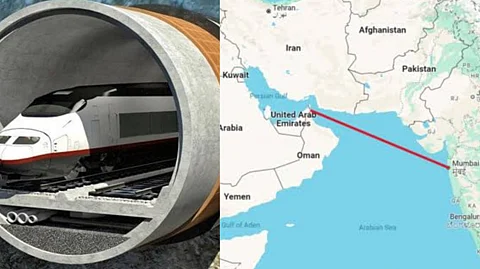

The UAE’s National Advisor Bureau Limited (NABL) has proposed a underwater high-speed rail corridor connecting Mumbai and Dubai. This 2,000-kilometer project, first conceptualised in 2021, promises to slash travel time between the two cities to just two hours at speeds of 600–1,000 km/h, rivaling air travel. While the vision is transformative, significant technical, financial, and environmental challenges loom.
Speed and Efficiency:
Trains will operate at 600–1,000 km/h, cutting travel time from the current 4-hour flight to 2 hours.Maglev (magnetic levitation) technology could enable frictionless, ultra-fast travel.
Underwater Route:
The rail link will traverse the Arabian Sea, offering passengers panoramic views of marine life through transparent tunnel sections.Depth and pressure challenges necessitate advanced engineering, similar to Japan’s Seikan Tunnel or the Channel Tunnel.
Dual Purpose:
Accommodate commuters, tourists, and workers.Facilitate oil exports from Fujairah (UAE) to Mumbai and freshwater transfers from India’s Narmada River to the UAE.
Floating Infrastructure:
Plans include floating fuel stations for ships and pipelines for resource exchange.
Strengthen India-UAE trade ties, projected to exceed $100 billion by 2030. The corridor could streamline crude oil imports to India and freshwater exports to the UAE. Boost tourism between the two nations, with Dubai attracting 2.4 million Indian tourists in 2024 alone. Reduce reliance on air travel, potentially lowering carbon emissions if powered by renewable energy.
Proposal Stage: The project remains conceptual, with no official government approvals yet. NABL shared a conceptual video on YouTube, but feasibility studies are pending.
Target Completion: 2030 (optimistic estimate).
The Mumbai-Dubai underwater rail link represents a bold leap in transportation innovation. While its potential to reshape trade and travel is undeniable, overcoming engineering marvels, securing funding, and ensuring environmental sustainability will determine its fate. For now, the project remains a fascinating glimpse into the future of global connectivity.
